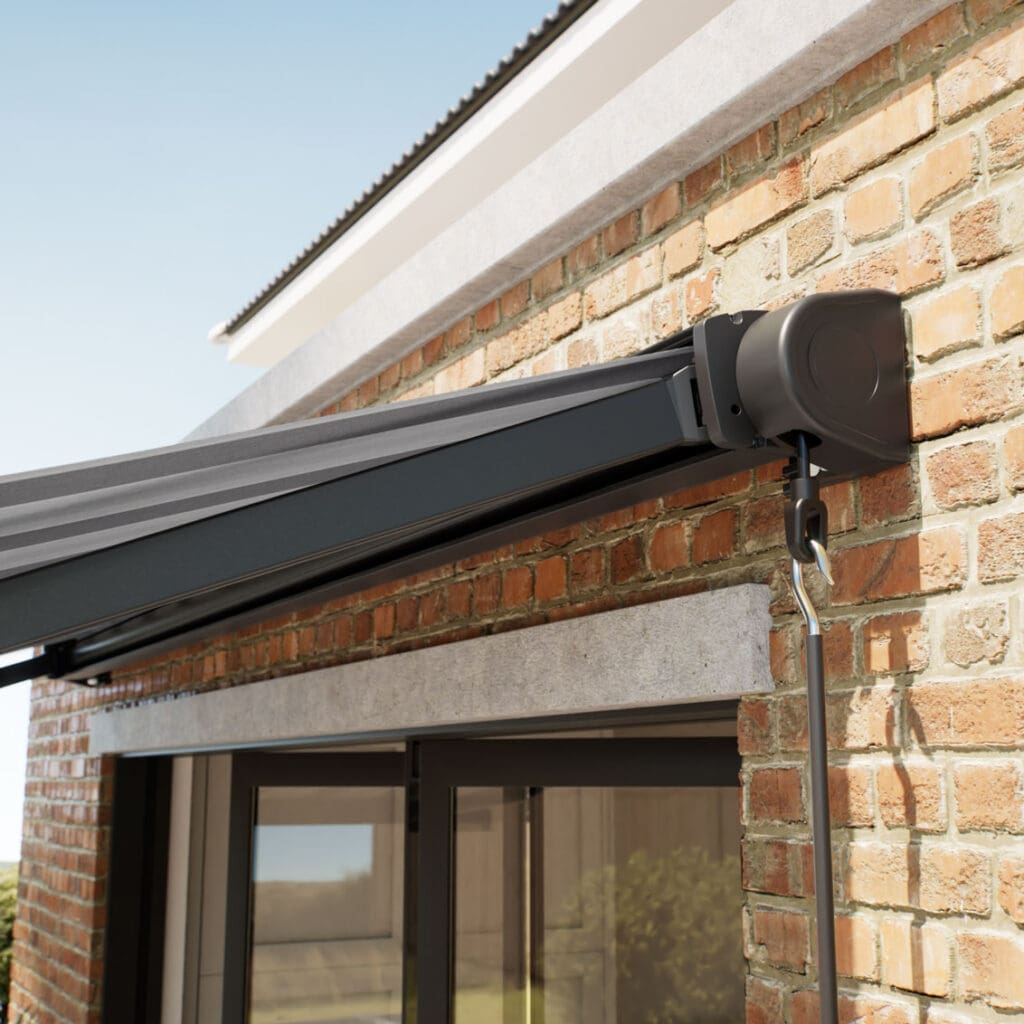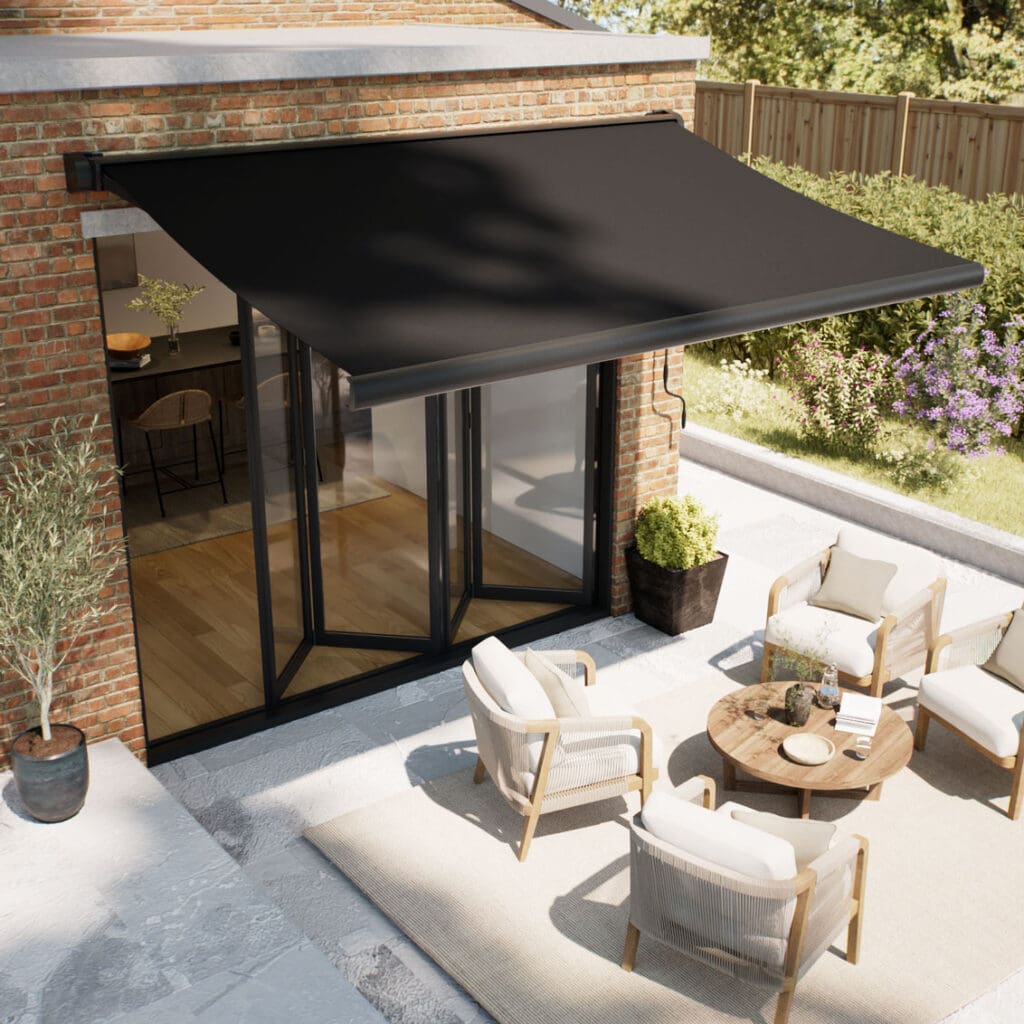Proper Awning maintenance is essential for preserving functionality and appearance, enhancing curb appeal, and extending lifespan. Here, we’ll outline our recommendations for cleaning Awnings, including clearing debris from the fabric, aftercare, and common FAQs.
Prepare Your Awning for Cleaning
Before beginning the cleaning process, check the weather forecast for dry conditions and avoid cleaning during windy weather to prevent debris from blowing onto the wet fabric.
Ensure your Retractable Awning is fully extended. This provides complete access to the entire fabric surface, reducing the likelihood of damage to the mechanism. Check that the Awning arms are securely locked in place to prevent accidental retraction while cleaning. Next, move outdoor furniture and decorative items away from the area.

Brush Off Loose Debris First
Start by removing loose debris from your Awning to prevent scratches and enhance cleaning efficiency. Use a soft-bristled brush or microfibre cloth to sweep away leaves, dirt, and dust, focusing on the seams and folds where debris is more likely to accumulate.
Regular brushing helps avoid material degradation, particularly at the points where the Awning meets the building or cassette. Make sure your Retractable Awning is fully extended and locked before starting debris removal.
Create a Cleaning Solution
To start cleaning Awnings, we recommend using a mixture of lukewarm, detergent-free soapy water. Avoid chemicals such as bleach, as this can potentially damage the fabric. Always test the solution on a small area before beginning the cleaning process.
Wipe Down the Fabric
- Apply the cleaning solution and take a microfibre cloth or soft sponge to wipe down the fabric, working from top to bottom to prevent dirty water from dripping onto any cleaned areas.
- Rinse the fabric with a garden hose on a gentle spray setting after, ensuring all soap residue is removed.
- Let the Awning air-dry completely to prevent mould growth before retracting or applying any treatments. Drying may take several hours to a full day, depending on weather conditions.
- Reproof your Awning – Reproofing the Awning fabric restores its protective qualities after cleaning. Ideally, it should be reproofed every 2-3 years or after deep cleaning.

Benefits of Cleaning & Maintaining Your Awning
Cleaning your Awning consistently can lead to the following benefits:
- Prevents mildew buildup – Mildew can cause discolouration over time.
- Avoids Tears – Removing any debris from your Awning regularly ensures there’s no dirt build up that can damage the fabric when retracting it into the cassette.
- Expands the lifespan – Cleaning your Awning properly means you can continue to create a stunning, outdoor statement for years to come.

Common FAQs When Cleaning Awnings
If you’re looking for more advice, here are some of your most common questions, answered:
Can I Use a Pressure Washer On Awnings?
Generally, avoid pressure washers as high pressure can damage fabric and seams. Instead, use a gentle setting on your garden hose.
Do I Need to Reproof My Awning After Cleaning?
Reproofing is advised every 2-3 years or after every deep clean to maintain water resistance, as it removes existing waterproof treatments. Apply a suitable reproofing product once the Awning is clean and dry.

What’s the Best Weather for Cleaning an Awning?
Ideal conditions are dry, overcast days with mild temperatures and little wind. Avoid direct sunlight and windy days, ensuring at least 4-6 hours of dry weather for complete drying.
Can I Clean an Electric Awning Whilst It’s Installed?
Yes, but protect electrical components. Fully extend and lock the awning in place, avoiding water on the cassette housing. If deep cleaning near electrical elements is necessary, take extra precautions by using a microfibre cloth to brush down any debris.
Explore Our Cleaning Guides Today
With your Retractable Awning looking as good as new, explore our other blinds cleaning guides today and find out our top tips to refresh every blind in your home.



